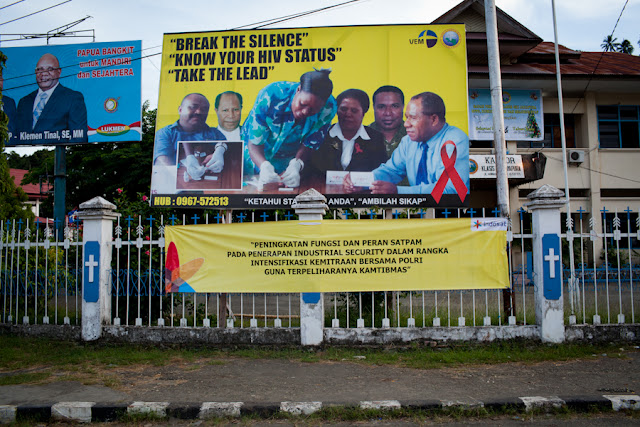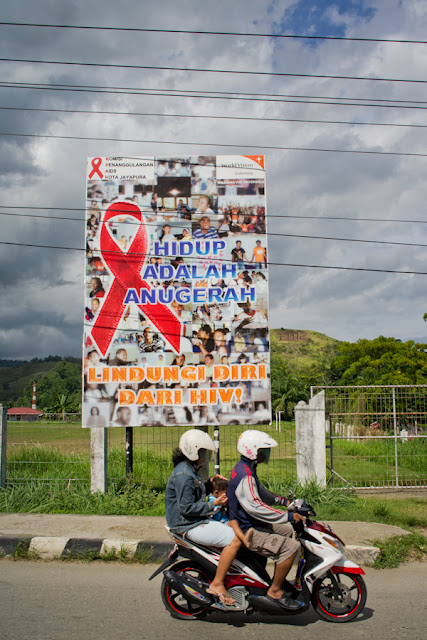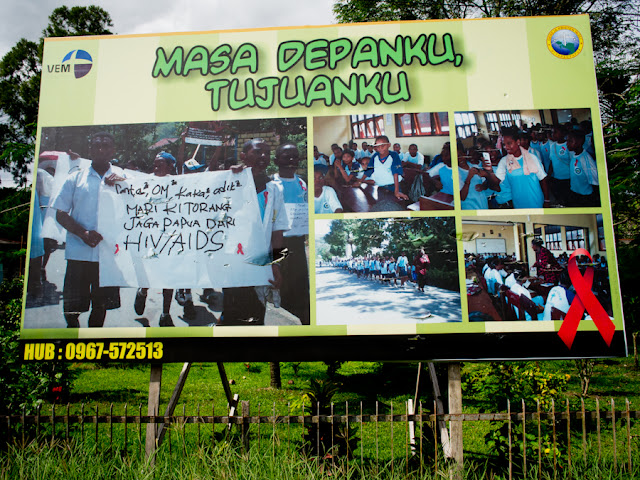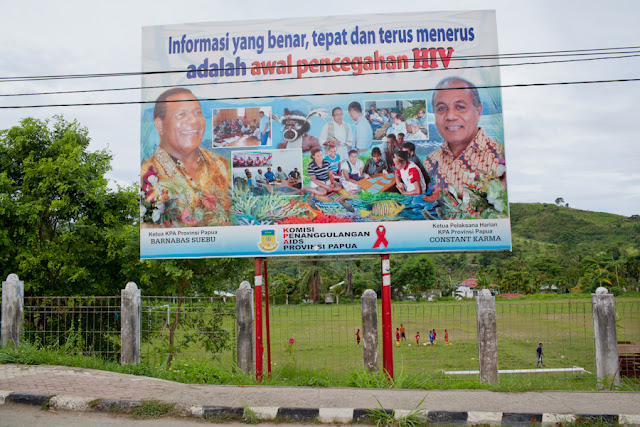A great friend in the fight against HIV/AIDS epidemic in Papua, Drs. David Wambrau passed away yesterday. Pak Wambrau founded Mother's Hope Foundation or Yayasan Harapan Ibu in 2001, an NGO in Jayapura with a mission to raise HIV/AIDS awareness and education and provide assistance and support to those facing infection and living with HIV/AIDS. He had given so much to his community as a professor, mentor, and advocate. His work and research have influenced my project. Thank you Pak Wambrau, your legacy will never be forgotten.
Friday, January 13, 2012
Thursday, January 5, 2012
W.H.
W.H. (47) originally from Wamena, a mountainous region in Papua has been HIV positive since 2001. However, has never been on Anti-Retroviral Treatment. "I don't want to take medicines because I am afraid that if I forget to take it even one day, my condition would get worst."
When W.H. feels sick, he would take a sharpened bamboo, razor, or glass and cut parts of his body (arm, leg, back, head, etc.) to let "dirty" blood (1-2 liters) out his body that he believes to cause his sickness. Afterward, he told me that he would feel healthier and have the energy to return to work in his small garden. As a small child in Wamena W.H. parents would cut his body when he got sick. However, this traditional practice is still common even today in cities like Jayapura among indigenous Papuans.
Fortunately, it has been many months since W.H. cut his body because he has been healthy. YHI or Yayasan Harapan Ibu (Mother's Hope Foundation) assists W.H. with providing him with food, transportation, and counseling.
*W.H. real name is kept to protect his identity.
 |
| W.H. in his small garden. |
ARV medication must be taken 2x per day at the same time everyday forever. Another reason that W.H. is currently not on ARV treatment is because he needs to eat before he take the medication. A consistent intake of medication is a great challenge to many indigenous Papuans such as W.H. who earns less than $1/day. They only eat if they have made enough money from selling their fruits and vegetables from their garden. W.H. daily diet is consisted of rice and vegetable. He told me he only eats meat when he has enough money to buy fish, chicken, or pork if there is a special event with food for guests.
Less than 10% of Indigenous Papuans who are HIV positive are on ARV treatment due to lack of education and insufficient support and assistance. Moreover, the percentage of health facilities that offer ARV is 23% according to National AIDS Commission (NAC). Thus, it's not available everywhere, mostly in cities and urban areas.
*W.H. real name is kept to protect his identity.
Wednesday, January 4, 2012
Billboards & Signs In Jayapura, Kotaraja, Abepura, Waena (Expo), & Sentani.
After arriving in Jayapura and getting situated, things didn't go as planned. Due to the holidays (Christmas & New Year), many organizations were closed and several of my contacts that could provide me with access and people that I want to photograph are out of town or busy with family matters.
Those who knows me personally thinks that I am a workaholic. But that's not entirely true, I prefer to stay productive. I can't sit around and wait things to happen. Plus, everyday I spend in Papua costs money so I have make sure it's worth while. To keep myself busy, I re-read hundreds of pages of research and compare them with recent data. I looked over my mission statement that I wrote for this project and visualize the kind of photographs that I would need to illustrate my objectives. I wrote down the people that I want to meet, interviewed, photograph, translated interview questions from English to Bahasa, checked flights to other cities in the region, cleaned my cameras and lenses, went to church on new year (it counts for the previous and current year) and explore Jayapura via walking and taxi.
But during my exploration of the city, I notice billboard signs along major roads connecting Jayapura to other nearby towns. These billboards are located in an area where thousands of people would easily drive or walk past them everyday. However, examining its content, these billboards are lacking some fundamental information, specifically mentioning condom as the most effective way in the prevention of HIV virus. In Papua, compared to Jakarta with a booming drug problem, HIV virus is transferred through sex almost all the time. However, not one mentions the word condom or even show how a condom looks like. The word HIV/AIDS is mentioned almost all the time but it doesn't explain what it is, how one would get infected to reduce stigma, where to get tested or counseling, and how to prevent infection.
According to National AIDS Commission (NAC), As of 2008 there are 15,000 condom outlets across Indonesia and that there had been 20 million condom distributed. However currently consistent condom use among Female Sex Workers is at 35%. Only 17% of men and women age 15-24 (more likely to be mobile, drink, and have sex at young age) reported they could condom on their own. Data from IBBS Tanah Papua (collected late 2006, published mid 2007) also indicated that the level of consistent condom use during sex is very low. Only 3.8% reported using a condom every time they had sex with a non-regular partner. Among females, consistent condom use was relatively high at 8.4%; while among males it was only 2.5% percent.
 |
| Another Billboard next to BKKBN, "Reminder World's AIDS day, protect workplace from HIV/AIDS." |
 |
| Another similar billboard on the main road like above "Reminder World's AIDS day, protect workplace from HIV/AIDS, " but competing with other billboards and next to a burning garbage dump. |
 |
| A billboard on the main road to Sentani with Graffiti, it reads "We care." |
 |
| A billboard with those two guys again that reads both in Bahasa and English, "Mingling is fine but improper mingling is no way." The sign targets promiscuity. |
1st Update - Jayapura
Happy New Year 2012. I hope all of you had a wonderful holiday.
 |
| Christmas Eve |
I am currently in Jayapura, the capital of Papua. I took an overnight plane from Jakarta on the December 19th. Despite the long delay, which is common in Jakarta, I safely arrived without any problem. Jayapura was the first city I visited when I first started working on this project. My aim is to meet up with doctors, nurses, social workers, researchers, and government officials to get the latest information and follow up on some of the people that I photographed.
Papua or formerly known as Irian Jaya is now divided into provinces, Papua and West Papua. Papua has the highest HIV/AIDS infection rate in the country, 15 times higher than the national average and the highest HIV/AIDS prevalence outside of Africa (estimated 2.4% prevalence among general population). HIV/AIDS does not discriminate along the lines of ethnicity but in Papua, indigenous Papuans are more likely to be infected. In fact, indigenous Papuans count for almost 75% of all HIV/AIDS cases in Papua.
My plan is to continue working on this project for almost 6 months and visiting 7 different cities:
Papua
My contact, Ibu Veneranda from Mother’s Hope Foundation (Yayasan Harapan Ibu), was kind enough to help find me an affordable room to rent during my month long stay here. The bare room pink curtain, green walls, one small window and shared bathroom costs around 500.000 IDR, equivalent to $55/month. (9000 IDR = $1). I had to buy a small mattress and fan ($20) for comfort, the only two pieces of “furniture” that I bought in over 2 years. Not that I am against furniture but buying them means commitment.
Papua or formerly known as Irian Jaya is now divided into provinces, Papua and West Papua. Papua has the highest HIV/AIDS infection rate in the country, 15 times higher than the national average and the highest HIV/AIDS prevalence outside of Africa (estimated 2.4% prevalence among general population). HIV/AIDS does not discriminate along the lines of ethnicity but in Papua, indigenous Papuans are more likely to be infected. In fact, indigenous Papuans count for almost 75% of all HIV/AIDS cases in Papua.
My plan is to continue working on this project for almost 6 months and visiting 7 different cities:
Papua
- Jayapura - One of the biggest cities and capital of Papua.
- Merauke - Port City and the first location HIV case was recorded in 1992
- Wamena - Mountainous area in the highlands with some urbanization and entry point to original tribes.
- Timika - The site of the biggest gold mine in the world and highest infection number in the region.
- Biak - One of the highest death rates with very little support, 135 death out of 588 infected (23%).
- Manokwari - Has one of the highest infection rates in this region.
- Sorong - High number of Transgender who are HIV positive.
 |
| Imbi Park, a popular place to buy sex, with a statue of General MacArthur. |
 |
| Children swim at ship-port |
 |
| Shipping Port in Jayapura. Passengers arriving and leaving for the holidays. |
There are better rooms that I could have found in town but I have a limited budget and numerous expenses. To make sure that I don’t run out of money, I need to live as cheaply as possible. My budget for food is around 50.000 IDR or $6 per day, and 1/3 of that goes to coffee, which is essential to get me through the day.
I get around town using local transportation. They call it taxi here, but it’s really a small van crammed with 15 people. They cost around 2000-3000 IDR or 25 cents per ride. Internet is around 5000-7000 IDR per hour and it’s super slow. Renting a car and a driver could costs around 250.000 or $20/day and I will definitely use it to get to remote locations. Not including cell phone, fixer, flights within the region, etc and these expenses doubles as I get into the highlands. After almost 6 months these expenses will sure add up.
Also I haven’t even included costs of visa extension and production such as multimedia, books, and film processing. My point is doing long-term documentary work is expensive and requires knowing how to live within a budget. In life it means choosing what we need over than what we want.
Also I haven’t even included costs of visa extension and production such as multimedia, books, and film processing. My point is doing long-term documentary work is expensive and requires knowing how to live within a budget. In life it means choosing what we need over than what we want.
After settling in my new home-base, I met up with my friends at Yayasan Harapan Ibu, a local NGO that provides education in raising awareness of HIV/AIDS and support to those already infected. They filled me in with all the latest information. I learned that two people that I photographed from my last visit unfortunately have died. A couple of teenage sex workers that I met last time are now in dire health condition and they’ve returned home to their families. Nevertheless, the average life expectancy for Indigenous Papuans with HIV/AIDS in Papua is 2 years.
| Yuli Elizabeth Yemo, died last year, she was 37 |
Awareness of HIV/AIDS is very low among indigenous. Limited access to basic health services and insufficient support has made it difficult for indigenous Papuans to get tested for HIV or receive adequate assistance and counseling. For example, only 31 percent of indigenous Papuans know where to get an HIV test. Condom is essential in preventing infection since almost all cases are spread through sexual relations but less than 30 percent could identify a condom and only 8 percent have used one. Most clinics that provide support and preventive services are located too far from those living in rural areas. Also, the majority of staffs in health sector are in-migrants with little knowledge of Papuan culture and value. This often led to biased or inefficient delivery methods of service. The availability of Anti-Retroviral drugs is erratic and medicines for opportunistic infection such as Tuberculosis or dietary supplements to help maintain health are also lacking. Furthermore, fear of abuse, persecution and ostracism from community and family members have made secrecy the primary concern rather than treatment. Thus, most of those who tested positive for HIV in Papua fled without seeking care.
To recap, my main objectives are:
- Economic disparity
- Lack of HIV/AIDS education and awareness
- Insufficient service and support
- Discrimination in health care
- Stigma
The question is how do I plan to convey these objectives visually? I will be focusing mainly on Indigenous Papuans facing infection and living with HIV/AIDS illustrating their hardships and obstacles in getting information, receiving preventive care, undergoing treatments, and facing stigma among individuals and topics such as:
-Andri
P.S. Special thanks to POYi Emerging Vision Incentive, Reminders Project Asian Photographers Grant, and a handful of generous individuals (despite not reaching my goal on Emphas.is) provided me with financial support to continue this project.
- A pregnant woman with HIV/AIDS.
- Parents taking care of their children or family members with HIV/AIDS.
- A husband/wife or boyrfriend/girlfriend living with HIV/AIDS
- A girl/boy coming of age and dealing with relationships and sex.
- Orphans
- Street sex workers and exploring "opportunistic" sex, cash or good in exchange for sex including transgender
- Brothels and Bars and its condition in contrast to Indigenous Papuans women working on the street
- Patients undergoing treatment, counseling, and check-up including first timers.
- Condition of hospitals, hospices, mobile VCT, and clinics as well as supplies such as condom and ARV availability.
- Mass Media such as billboards and public events that create any awareness.
- The role of church and spiritual leaders against stigma
- Life Skills Education (LSE) taught in schools in raising awareness about condom and HIV/AIDS.
-Andri
P.S. Special thanks to POYi Emerging Vision Incentive, Reminders Project Asian Photographers Grant, and a handful of generous individuals (despite not reaching my goal on Emphas.is) provided me with financial support to continue this project.
Subscribe to:
Posts (Atom)



















